Dodge Journey: Removal
WARNING: Refer to the applicable warnings and cautions for this system before performing the following operation. Failure to follow these instructions may result in serious or fatal injury.
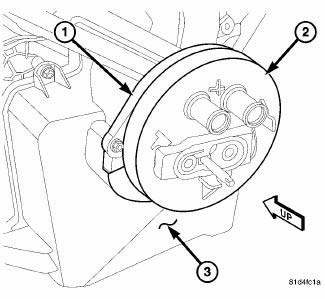
Fig. 273: Rear Housing Flange Seal
1. Disconnect and isolate the negative battery cable.
2. Remove the rear heater-A/C housing and place it on a workbench.
3. Remove the foam seal (2) from the flange (1) located at the bottom of the rear heater-A/C housing (3). If the foam seal is deformed or damaged, it must be replaced.
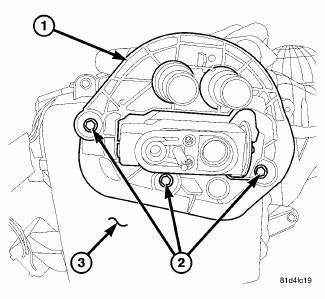
Fig. 274: Rear Housing Flange
4. Remove the three screws (2) that secure the flange (1) to the bottom of the rear heater-A/C housing (3) and remove the flange.
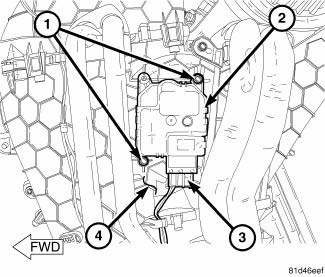
Fig. 275: Rear Blend Door Actuator Removal/Installation
5. Disconnect the wire harness connector (3) from the rear blend door actuator (2) located on the outboard side of the rear heater-A/C housing (4).
6. Remove the two screws (1) that secure the rear blend door actuator to the rear heater-A/C housing and remove the actuator.
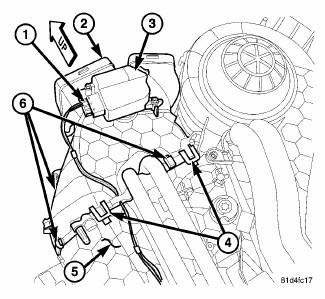
Fig. 276: Rear Distribution Housing Removal/Installation
7. Disconnect the wire harness connector (1) from the rear mode door actuator (3) located on the outboard side of the rear heater-A/C distribution housing (2).
8. Remove the three metal retaining clips (4) that secure the rear distribution housing to the rear heater-A/C housing (5).
9. Release the five plastic retaining tabs (4) that secure the rear distribution housing and rear heater-A/C housing together and separate the housings.
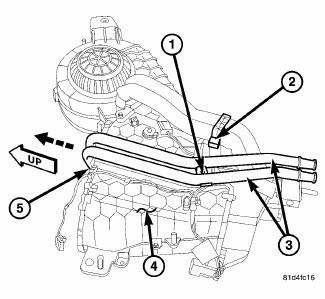
Fig. 277: Rear Heater Core Remove
10. Remove the screw (1) that secures the rear heater core tubes (3) to the outboard side of the rear heater- A/C housing (4).
CAUTION: To prevent damage to the plastic evaporator tube bracket, carefully guide the heater core tubes past the bracket during removal of the heater core.
11. Carefully pull the rear heater core (5) out of the top of the rear heater-A/C housing. Guide the heater core tubes past the plastic evaporator tube bracket (2). If the foam seals on the heater core are deformed or damaged, they must be replaced.
 Description, Operation
Description, Operation
DESCRIPTION
Fig. 272: Rear Heater Core Description
The rear heater core (1) is located in the rear heater-A/C housing behind the
right interior quarter trim panel.
The rear heater core is a h ...
 Installation
Installation
CAUTION: To prevent damage to the plastic evaporator tube bracket,
carefully guide
the heater core tubes past the bracket during installation of the heater
core.
Fig. 278: Re ...
See also:
EMISSIONS INSPECTION AND MAINTENANCE PROGRAMS
In some localities, it may be a
legal requirement to pass
an inspection of this vehicle’s emissions control system.
Failure to pass could prevent vehicle registration.
For states that require a ...
Description, Operation
DESCRIPTION
Fig. 418: Identifying Ignition Key/Switch Positions
- LOCK
- ACC
- ON
- START
The Brake Transmission Shifter/Ignition Interlock (BTSI) is a solenoid
operated system that ...
Seal, oil pump
REMOVAL
Fig. 367: Removing Oil Pump Seal
- SEAL PULLER C-3981-B
- OIL PUMP SEAL
1. Remove transaxle from vehicle.
2. Using Seal Puller C-3981B (1) , remove oil pump seal (2).
INSTALLA ...
